For over 100 years, the list of German spies executed by Britain has included the name of a German-American, Irving Guy Ries. While many sources acknowledge that this name was a pseudonym, they simply note that the man named Ries did not wish his real name divulged in order to avoid embarrassing his family.
Over the last few years however, his name has squeaked out – Paul Hensel. The story of how he came to carry the name Irving Guy Ries is a fascinating one.
The Real Irving Guy Ries
In 1889, Peter Leonard Ries (born 1867) married Caroline S. Yeager (born 1866). Both Peter and Caroline had been born in Ohio although Peter’s father, had been born in Kassel, Germany while Caroline’s parents had been born in Switzerland and France.
The couple had five children:
- Irving Guy Ries – born 15 Jan 1890 in Akron, OH
- Raymond Chester Ries – born 7 May 1894 in Akron, OH
- Park Joseph Ries – born 14 Nov 1897 in Akron, OH
- Leonard Paul Ries – born 9 Nov 1899 in Akron, OH
- Frank Albert Ries – born 13 April 1907 Akron, OH
Peter ran a print shop with his brother, Wallace Ries, as early as 1900 and sold cameras and photographic equipment. This may be how all five of his sons developed an early interest in photography.
By the time he was twenty years old, in 1910, Irving had enough photography experience to land a job with the Industrial Film Company of Chicago (IFC). His younger brother Ray ran motion picture projectors in movie theatres.
In 1912, two cinematography clubs joined together to form the American Society of Cinematographers and both Ray and Irving were listed among the founding members when the charter was issued in California in January of that same year. Chicago and New York were no longer the centres of the motion picture industry as companies moved west to California where the climate was more conducive to year-round film-making.
In March 1912, Irving went to Mexico for sixth months to make a movie about the Mexican Civil War for the Feature Film Company of Chicago. The film was released in 1913 and while capturing the fighting in Mexico City, also showcased traditional Mexican tourist attractions. This film would set Irving up for an even grander adventure.
Early in 1915, after the onset of the First World War, Irving was offered a job as photographer for On the Firing Line with the Germans. In March 1915, Irving applied for a passport to travel to Germany, England and Belgium to document the battlefields of the war. Irving worked under Durborough, a field photographer with the Newspaper Enterprise Association of Chicago. He apparently chose Irving to be his associate because the young man was of German descent (his grandfather was German), was fluent in German and had previous experience filming on location (Mexico). Durborough bought a Stutz Bearcat touring car in Chicago which accompanied the pair when they sailed from New York on 25 March 1915 aboard the New Amsterdam. The film crew was embedded within the Germany army for the duration of the spring and summer. Durborough returned to the US in August 1915 while Irving returned by mid-October 1915.
The film, On the Firing Line with the Germans, opened in Milwaukee on 2 November 1915 and in Chicago on 6 December 1915. Durborough attended the showings and personally presented and narrated the film.
As for Irving, by 1917, he had moved to Santa Monica, where he lived for the rest of his life. In 1916, he married Genevieve L. Beaumont in Chicago with whom he had one daughter. He continued to be involved in the moving picture industry, filming the first Laurel & Hardy movie in 1920 (Lucky Dog) as well as several other early ones.
On 1 May 1923, three of the Ries brothers, Park, Paul and Ray, all resigned from their jobs at various motion picture studios to open a photography business and camera store at 6035 Hollywood Boulevard. In 1924, Irving joined these same three brothers in forming the Ries Brothers Building and Investment corporation with a view to building apartment buildings.
Metro Goldwyn Mayer was founded in 1925 and a few years later, both Irving and Ray joined the company and worked there for most of the remainder of their careers. Apparently Irving started the special effects section at MGM, as well as coining the term “special effects”.
Over the next few years, Park, Paul and Ray, continued to expand their photography business while Irving focused on making motion pictures (e.g. Tarzan the Ape Man (1932)). The fifth brother, Frank, quite a few years younger than his siblings, worked as an employee for his older brothers for a time before striking out on his own. His business was, however, a shade different from that of his siblings, filming stag movies (pornography). Although arrested several times, his stash of pornographic motion pictures was not discovered by the authorities. Still, after spending a year in prison in 1945, he was unable to resume his operations with his associates and former business contacts. He and his wife committed suicide in 1947.
Somewhere between 1930 and 1934, Irving and his wife Genevieve divorced and Irving married Caroline Rambeau in 1934.
That same year, the Ries brothers released their first wooden tripod. It proved to be a hit with photographers and became much sought after. Even the well known photographer, Ansel Adams, used a Ries tripod. As for Irving, he provided special effects for a number of films, including the classic Singin’ in the Rain (1952). In 1956, Irving was involved in the production of Forbidden Planet and he and two co-workers were nominated for an Academy Award for their special effects, losing out to The Ten Commandments.
Irving passed away on 20 August 1963 having been involved in the production of over 500 films. His name, however, would live on in espionage literature as the spy who was executed by the British on 27 October 1915.
Theft of a Passport
So… how did an American cinematographer’s name get appropriated by a German spy? In 1915, Irving traveled to Germany with an American passport. He surrendered his passport to the German police for 24 hours upon arrival, enough time for the Germans to make a forgery. It didn’t take them long to put it to use.
On 9 August 1915, a man named Irving Guy Ries presented his passport to the American Consul General in England seeking a visa to travel to Rotterdam. The passport was identified as a forgery and the man was detained and handed over to the British. The real Irving G. Ries was still in Germany, filming with Durborough, but there was some confusion as to whether he was really there or not. The authorities weren’t sure if they had the real Irving Guy Ries on their hands or an imposter. What the British authorities did know was that Ries had been gathering information to send to the enemy on his aborted trip to Rotterdam.
On 27 October 1915, the fake Irving Guy Ries was executed at the Tower of London by a firing squad made up of 3rd Battalion, Scots Guards. He would go down in the history books as Irving Guy Ries, only revealing his real name to his attorney and in a confessional letter the night before his execution. On the morning of his execution, Hensel shook hands with the members of the firing squad and told them “You are only doing your duty, as I have done mine”.
Upon his return to the USA in late 1915, the real Irving was the subject of an investigation by the U.S. Department of Justice which was eventually dropped. The department had conducted some investigations during the summer of 1915 but were awaiting the return of Durborough from Germany. A few years later, Irving received his draft notice although given that he was “short” and “stout” one wonders if he actually served with the US fighting forces. In 1942, he also received a draft notice so obviously the US government was not bothered by the passport trouble from 1915.
Photographic Confusion
Much of the information above has come from an article by Robert Peters on the Ries brothers published in 2014 in The Journal – the New England Journal of Photographic History (opens as a pdf). The article includes a number of photographs of Ries (young and old) and a photograph of his imposter but two of these are incorrect. I reached out to Bob Peters and he said that he became aware of the incorrect photographs when the article was going to print. He contacted the editor of The Journal and a correction was to have been published in a subsequent edition of the magazine, but it never was. I’m taking this opportunity to clear up the confusion.
The photograph below was taken in March 1915 and is a photograph of Irving Guy Ries, the real one. The photograph matches his passport application photograph from 22 December 1915 (see below). This was after the entire forged passport debacle with the fake Ries. The real Irving planned to travel to Mexico on commercial business and gave his occupation as “professional photographer.
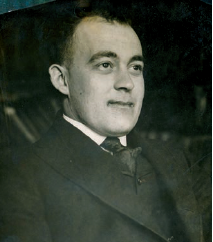
The photograph below is of Irving Guy Ries from his 22 December 1915 passport application, clearly a match to the photograph above.
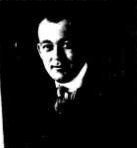
The confusion arises when Peters initially thought that the photographs from the neighbouring passport applicants were those of Ries or his doppelganger. This is easy to do since the photographs are attached to the reverse side of the passport application, placing them in juxtaposition to the front page of the next passport application.
Each passport application consists of two pages, a front side and a reverse side. On Ancestry, the applications appear in sequential order via two page spreads, with the reverse of one application on the left-hand side and the forward side of the following application on the right-hand side.
In the image below, the left-hand page is the reverse side of the 6 December 1915 passport application for London-born Richard William Batty. The right-hand page is the front side of the real Irving Guy Ries passport application from 22 December 1915. See photograph above.
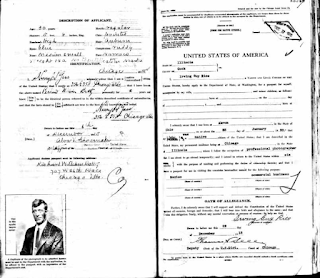
right side – reverse page of Richard William Batty application
left side – front page of Irving Guy Ries application
Similarly, in March 1915, we find the following two page spread. On the left-hand side, we have the reverse page for the 8 March 1915 passport application of Samuel James Harris, born in Boston. On the right-hand side, we have a copy of the front page of the 8 March 1915 passport application of the real Irving Guy Ries. Note the hand-writing on Ries’s application which mentions that the original application was sent to the Department of Justice. This explains why, Irving’s application has no signatures and no photograph on the reverse side.
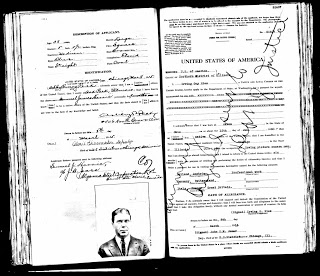
right side – reverse page of Samuel James Harris application
left side – front page of Irving Guy Ries application
In the 2014 edition of The Journal, the article includes the following photograph on page 20. The caption reads: “Figure 8, left. The ‘counterfeit’ Irving Ries, Carl Paul Julius Hensel.” This is incorrect. The photograph on the left is that of Richard William Batty (seea above). Similarly, the caption for the next photograph in the pair below reads: “Figure 9, right. The real Irving G. Ries.”. This is also incorrect. The photograph on the right below is that of Samuel James Harris. Even a cursory look at the two photographs below, compared with the photograph of the real Irving Guy Ries (see above – March 1915), will show that they are not of the same man.
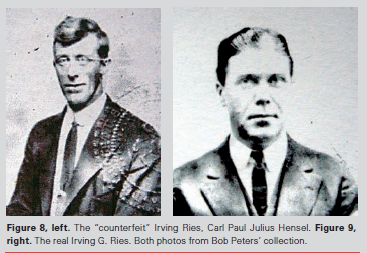
Note: These photograph captions are NOT accurate and the two men pictured have nothing to do with either Irving Guy Ries or Carl Paul Julius Hensel.
Left – Richard William Batty and Right – Samuel James Harris
Finally, we have the well-known photograph of the imposter, Paul Hensel. Again, the two photographs above are clearly not connected to either of the two Irving Guy Ries’, neither the real one nor the fake one.
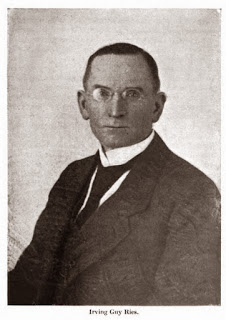
I’ve spent a bit of time outlining the photographic confusion because there is nothing worse than having an error like this propagate around the internet.
I do want to note that, other than the passport photo confusion, Peters’ article is quite well done and provides a wealth of information on the real Irving Guy Ries and his brothers.
Tantalizing Glimpses of the Paul Hensel
As for the actual man executed at the Tower of London on the morning of 27 October 1915, his name, according to Bob Peters was Carl Paul Julius Hensel. So far, however, I have only come across references to a “Paul Hensel” or a “Carl Hensel” in other books and documents.
Writing in 1920, a few years after the execution, Sidney Theodore Felstead, in his book, German Spies at Bay, noted:
When told he was to be shot [at the Tower of London] at dawn the following morning [the false Ries’s] studious reserve broke down for the first time, and late that night in the Tower, possibly under religious influence, he called for writing materials and wrote out a full confession of his guilt, giving also his true name. No good purpose would be served by revealing it now. His people were respectable citizens of the United States, to whom the public knowledge of their son’s ignominious death would be nothing but a source of everlasting shame.
The first hint of the doppelganger’s real name appears in 1940 in various newspapers in the States, although the facts are a bit muddled. The French apparently exhibited a display of spy paraphernalia, including a letter that Hensel/Ries had written to a company in Chicago. The newspaper reports seem to have concluded that Hensel/Ries was executed by the French which is incorrect.

Leonard Sellars book, Shot at Dawn, has quite a bit of information on the case of the false Irving Guy Ries but makes no mention of the name “Paul Hensel”. Sellars does note however that the false Ries had been born in Chicago and was 55 years old (born 1860). The false Ries claimed that his father was Dutch and that his mother was Scottish. Sellars noted that the files and papers he examined on “Ries” contained no information on the man’s real name.
While there is no Security Service file on Ries at the National Archives (Kew) (only a DPP file and a WO file), there is an intriguing file in the Foreign Office section (FO 383/187) which dates from 1916. The contents list for the file shows a variety of documents relating to German prisoners including this line: “Paul Hensel, German subject executed at the Tower of London in October 1915: letters written by him, including his will.” I am going to venture a guess that this file contains Hensel’s real name. Unfortunately, the file is not digitized so viewing it will have to wait until travel resumes.
The first reference I have found in published sources is Nigel West’s Historical Dictionary of World War I, which notes that the false Ries’s real name was “Carl Hensel”. But the following year, Chris Northcott’s book, MI5 at War: 1909-1918 notes that the doppelganger’s real name was “Paul Hensel”. I haven’t seen either book, just examined snippets via Google Books.
I also came across another reference, a book by Thomas Boghardt entitled Spies of the Kaiser: German Covert Operations in Great Britain during the First World War Era. Published in 2004 by Palgrave Macmillan, the book is historical treatise on German activities in Great Britain but gives very little space to the executed spies. Far more attention is given to some of the pre-war agents. I had hoped that the book, which I ordered from the library, might give a bit more information on Carl Paul Julius Hensel but was disappointed.
On the other hand, Boghardt’s book does note that the Peruvian spy, Ludovico Hurwitz-y-Zender, was actually a pseudonym for Adolf Weiszflog. Apparently, by the time he was apprehended by the British, Adolf Weiszflog, a naval agent, had already completed four missions for Germany and been awarded the Iron Cross for his achievements. That is a tantalizing tidbit but there is no further information or background to provide a jumping off point for further research. The book also notes that Albert Meyer was not a Dane, but rather a German national.
Conclusion
The Ries Brothers article has provided a wealth of information on the real Irving Guy Ries and it is quite clear that he had absolutely no connection to the German spy, Paul Hensel. The German tradition of handing in your passport to your hotel front desk for 24 hours, so that the information could be registered with the local police, gave the German authorities access to ready-made covers for their spies.
The real Irving Guy Ries was simply an innocent victim who likely was unaware of the hubbub until he arrived back in the US in October 1915, a few short days before his doppelganger was executed at the Tower of London. One does wonder if news reports of the doppelgangers death, carrying the name Irving Guy Ries to his grave, ever caused problems for the real Irving.
As for the doppelganger. While his name might have been Carl Paul Julius Hensel, or Paul Hensel or Carl Hensel, one wonders if he gave his correct age (55 years old). Unless the FO documents contain something concrete, it is unlikely that we will ever really know who he was, where he came from and why his family was so important that they needed to be protected from the shame of family spy.
For those interested, the film that the real Irving Guy Ries made, On the Firing Line with the Germans, is available for viewing via this link.
Sources
The Ries Brothers and Their Place in Hollywood History, by Robert Peters. Published in The Journal – New England Journal of Photographic History, 2014, Issue 172, pp. 14-34.
Spies of the Kaiser: German Covert Operations in Great Britain during the First World War Era. Thomas Boghardt. 2004, Palgrave Macmillan, Oxford.
German Spies at Bay. Sidney Theodore Felstead. 1920, Hutchinson, London.
Shot in the Tower. Leonard Sellars. 1997, Leo Cooper, Leonard.
Fold3 (Ancestry) – Investigative Reports of the Bureau of Investigation 1908-1922, M1085, case #7913.
Ancestry – genealogy records
(Header image from Library of Congress – American correspondent William H. Durborough with German Soldiers – ca 1915).
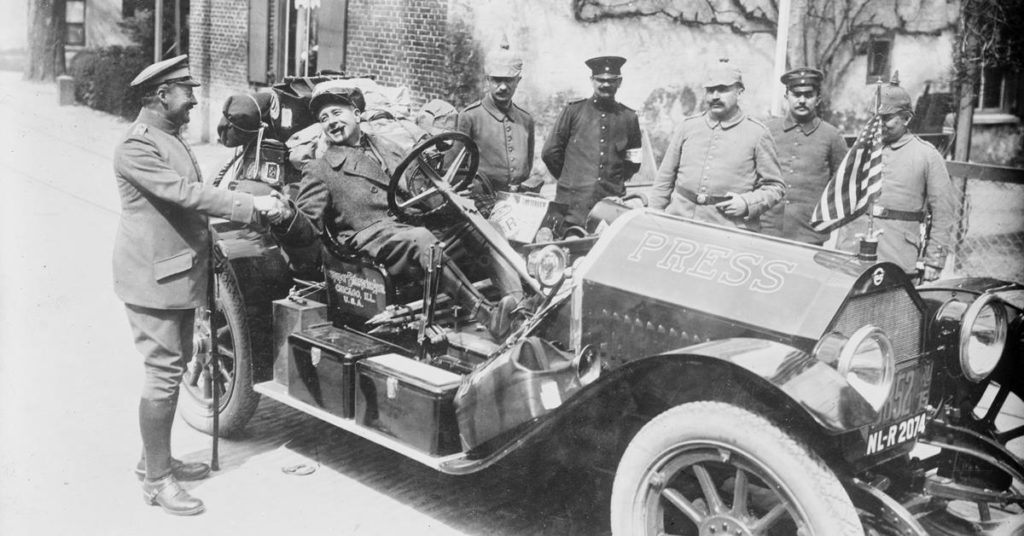
You might add “On the Firing Line with the Germans” which is posted on Youtube. Additionally, Irving Reis was awarded the Iron Cross by the Germans.
Thanks Robert!
So interesting. Thank you
Thanks Susan!
A really interesting read
You are welcome!
I am just after watching a channel 5 tv programme called ,’Inside the tower of London’, and it mentioned the German spy Irvine Guy Ries and the story of his execution. It did mention the forged passport and plenty about the true IGR but little was known apart from the name Paul Hensel, as the original identity of the spy. Your article muddies the water further by mentioning another name. It just asks the question what was the true identity of the real spy executed 8n the Tower ?
Hi Lenny, thanks for your comment! Which other name did I mention? I just reviewed the article and other than Carl Paul Julius Hensel, which is just a variant of Paul Hensel, I’m not sure what you are referring to. Have I missed something?
Thanks!